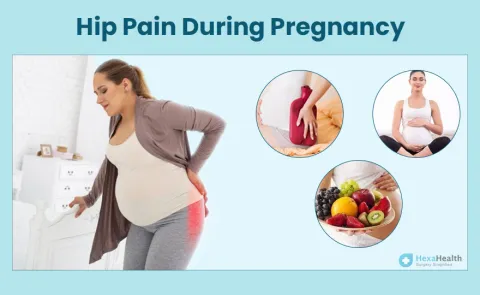Abdominal After Delivery Belt - How to Use, Benefits, Results

Quick Summary
- After-delivery belts have been used for centuries to help women recover after childbirth.
- The belt helps to restore the abdominal muscles to their pre-pregnancy state by providing support and compression to the area.
- While the use of an after-delivery belt is not a substitute for proper exercise and a healthy diet, it can be a helpful tool in aiding recovery after delivery of a child.
The after-delivery belt has been used for centuries in various cultures to help women recover after childbirth. It is believed that the belt helps to restore the abdominal muscles to their pre-pregnancy state by providing support and compression to the area.
While the use of an after-delivery belt is not a substitute for proper exercise and a healthy diet, it can be a helpful tool in aiding recovery after delivery of a child. In this article, we will explore the benefits of using an abdominal belt after delivery, how to use one, and some things to consider before making a purchase.What is an After Delivery Belt?
An after-delivery belt, abdominal or postpartum or postnatal belt, is a specialised garment designed to support and compress a mother’s abdominal muscles after delivery. It is typically made of elastic or breathable fabric and is worn around the abdominal area to help provide stability and comfort during the postpartum recovery period.
After giving birth, a mother’s abdominal muscles can become weakened and stretched due to the physical changes that occur during pregnancy. An abdominal belt can help by providing gentle compression, which can help to tone and support the abdominal muscles, reducing discomfort and providing additional support to the lower back and pelvis.


Benefits of an After Delivery Belt
Using an abdominal belt after delivery is a common practice among new mothers. An abdominal belt is a helpful tool that supports the abdominal muscles and reduces discomfort and pain after childbirth. Apart from this, there are several other benefits of using an abdominal belt post-pregnancy. Some of the benefits are as follows.
- Increased Blood Flow: Wearing a belly belt after delivery helps improve circulation, bringing fresh oxygen and nutrients to the abdominal muscles and aiding in the recovery process.
- Improved Healing of Muscles and Incision: The gentle support and pressure provided by an abdominal belt after C-section delivery can help promote the healing of both abdominal muscles and C-section incisions.
- Pain Relief: The abdominal belt helps to stabilise the abdominal muscles and reduce strain on the lower back, providing relief and promoting comfort during the healing process.
- Enhanced Mobility: Mobility is crucial for new mothers as they care for their newborns. The abdominal belt post-pregnancy can support the abdominal area, allowing new mothers to move around more comfortably and efficiently.
- Reduced Swelling: Swelling and inflammation in the abdominal area are common after childbirth, especially after a C-section. Wrapping up and after-delivery belt can help reduce swelling and inflammation in the abdominal area, particularly after surgery. This can help minimise discomfort and promote faster recovery.
- Improved Posture: Proper posture is essential for new mothers, especially during postpartum recovery. And after-delivery belts can help new mothers maintain proper posture while sitting, standing, and moving around, which can help reduce stress on the back and neck. This can be especially beneficial during breastfeeding or when engaging in various activities while caring for the newborn.
It is important to use an abdominal belt as directed by a healthcare professional and ensure proper fit and comfort to ensure safe and effective use during postpartum recovery.
Best Time to Wear an After Delivery Belt
The best time to wear an abdominal belt after delivery may vary depending on the specific circumstances. Women may feel the need for an abdominal belt depending on the type of delivery of the complications in the pregnancy.
- First Pregnancy: If it is the first pregnancy, it’s generally recommended to start wearing an abdominal belt after delivery once the mother feels comfortable and the healthcare provider gives the green light. This is usually after the first few days to a week, once the initial postpartum bleeding has decreased and any incisions (if applicable) have started to heal.
- Second Pregnancy: For women who have had a previous pregnancy, the timeline for wearing an abdominal belt may vary depending on their recovery and comfort level. Some women may start wearing the abdominal belt sooner after delivery, especially if they experienced abdominal separation in their previous pregnancy and want to provide additional support to their abdominal muscles.
- After C-section: If one has had a C-section delivery, it’s important to follow the healthcare provider’s advice on when to start wearing an abdominal belt. Typically, waiting until after the incision has healed and any staples or stitches have been removed is recommended. This is usually around 2 to 3 weeks after delivery, but it may vary depending on individual recovery.
- Normal Delivery: Women who have had a vaginal delivery without complications may start wearing an abdominal belt as early as a few days after delivery once they feel comfortable. It is important to listen to one’s body and not wear the belt too tight, as it should provide gentle support without causing discomfort.
- Twin Pregnancy: In the case of a twin pregnancy, the abdominal muscles may be under increased strain due to the larger size of the uterus and additional weight. Therefore, wearing an abdominal belt can provide additional support to the abdominal muscles.
It’s best to consult with a healthcare provider to determine the appropriate timing for wearing the abdominal belt after delivery, as it may vary depending on the individual circumstances.
Types of After Delivery Belt
Different types of abdominal belts exist in the market, and choosing the best one can significantly affect the results. Here are some types of the best abdominal belt after delivery to consider:
- Elastic Wraps: To gently support the abdominal muscles, elastic wraps are constructed of a stretchable material that may be stretched around the abdomen.
- They may be worn snugly but not too tightly and are simple to adjust.
- Elastic wraps can be a nice option for new mothers seeking minimal assistance during their postpartum recovery.
- Shapewear: Body-smoothing and body-shape clothing are known as “shapewear.”
- The abdomen region can be supported by some forms of shapewear that are specially made for postpartum recovery.
- Although some types of shapewear may be too tight or painful, it’s vital to remember that not all are appropriate for postpartum rehabilitation.
- Support Belt: A support belt is a type of after delivery belt designed to support the abdominal and lower back muscles.
- It may be a good option for new mothers experiencing back pain or discomfort during their postpartum recovery.
- Support belts can be adjusted to provide a custom fit and worn discreetly under clothing.
- Postpartum Girdles: Postpartum girdles are similar to support belts but are typically made of a firmer material and provide more compression.
- They are designed to give support to the abdominal muscles and can also help shape the waistline.
- Some types of postpartum girdles may also support the hips and lower back.
- Belly Binding: Belly binding is a traditional practice that involves wrapping the abdomen with a long strip of cloth.
- The cloth is wrapped tightly around the abdomen to support the abdominal muscles and promote healing.
- Belly binding can be a good option for new mothers looking for a natural and non-invasive way to support their postpartum recovery.
How to Use Abdominal Belt?
Using an abdominal belt after vaginal or C-section delivery can provide several postpartum pain and discomfort. However, it is important to use the belt correctly to get the maximum benefit.
After Vaginal Delivery
To use an abdominal belt after vaginal delivery follow the below steps.
- Wait until your doctor gives you the green light: It is important to wait until your doctor has given you the go-ahead to use an abdominal belt after delivery, as using it too soon could cause damage to your body.
- Choose the right size: Abdominal belts come in different sizes, so it is important to choose one that fits you correctly. A belt that is too tight can be uncomfortable and restrict blood flow, while one that is too loose will not provide the necessary support.
- Clean the area: Before putting on the abdominal belt, clean the area around your abdomen with warm water and soap. Dry the area thoroughly to prevent skin irritation.
- Lie down on your back: To put on the abdominal belt, lie down on your back with your knees bent and your feet flat on the bed.
- Place the belt under your abdomen: Slide the abdominal belt under your abdomen and position it so that it covers your lower abdomen.
- Fasten the belt: Fasten the belt securely but not too tightly. Make sure it is comfortable and does not restrict your breathing.
- Wear the belt for short periods at first: It is recommended to wear the abdominal belt for short periods at first, gradually increasing the amount of time you wear it each day. This will allow your body to adjust to the support provided by the belt.
C-Section Delivery
To use an abdominal belt after C-section delivery follow the below-mentioned steps.
- Wait for the doctor's approval: Before using an abdominal belt after a C-section delivery, it is essential to wait for the doctor's approval. This is usually after the first follow-up appointment, where the doctor checks the incision and ensures that the healing process is going well.
- Choose the right size: It is important to choose the right size of the abdominal belt to ensure that it fits snugly but not too tight. Wearing a belt that is too tight can cause discomfort and hinder the healing process.
- Place the belt correctly: Place the belt around the midsection, making sure that it sits just above the incision and below the ribcage. The belt should fit snugly but not too tight.
- Start using the belt gradually: It is recommended to start using the belt gradually, for a few hours a day and then gradually increasing the time as the body gets accustomed to it. This helps the muscles to recover and regain strength slowly.
- Wear the belt during activities: It is recommended to wear the belt during activities that require physical effort or movement, such as walking or lifting objects. This helps support the abdominal muscles and prevents strain or injury.
- Keep the belt clean: It is important to keep the abdominal belt clean by washing it regularly with mild soap and water. Make sure to air dry the belt before wearing it again.
Safety Tips for Binding Abdominal Belt
Only some people choose to wear an abdominal belt after delivery. However, there are certain things to consider, even though they can help one’s body heal and reduce post-operative pain.
- Choose The Right Size: It’s crucial to select the correct size abdominal belt after giving birth. Wearing a belt that is too tight or too loose can cause discomfort and strain on the abdomen. One should measure the waistline accurately and follow the manufacturer’s guidelines to choose the right size for one’s body.
- Never Wear it Too Tight: It’s important not to wear the abdominal belt too tight, as it can restrict breathing and blood circulation. Wearing it too tight may also cause discomfort and pain and can even lead to skin irritation and other health issues. The belt should fit snugly but not be overly tight.
- Limit Usage Time: It’s recommended to limit the usage of the abdominal belt for a specific period, usually 2 to 12 weeks, as advised by the healthcare provider.
Wearing the belt for too long can lead to discomfort and skin irritation and affect overall health. Follow the instructions provided by the healthcare provider or the manufacturer on the appropriate duration of usage. - Take Breaks: It’s important to give one’s body regular breaks from wearing the abdominal belt. Taking breaks allows the body to rest and breathe.
It is advisable to remove the belt for short periods, especially during activities like sleeping, bathing, or when one feels some discomfort. Listen to the body and take breaks as needed. - Don’t Use It During Exercise: Avoid wearing the abdominal belt during exercise or physical activities. The belt can hinder one’s movement and breathing, which may lead to discomfort, strain, or even injury. It’s important to allow the body to move freely during exercise without any restrictions.
- Follow The Manufacturer’s Instructions: Always read and follow the manufacturer’s instructions on how to properly use and care for the abdominal belt. Each belt may have specific guidelines on usage, cleaning, and maintenance. Following the instructions will ensure that mothers use the belt safely and effectively.
- Listen to The Body: Pay attention to any discomfort, pain, or skin irritation while wearing the abdominal belt. If one experiences any negative effects, removing the belt immediately and consulting with the healthcare provider is advised. Listening to one’s body and prioritising its comfort and health is essential.
When to Consult a Doctor?
After delivery, abdominal belts can provide support and help in regaining muscle strength and the shape of the abdomen. However, it is important to use the abdominal belt properly and know when to consult a doctor to avoid any complications. Here are some situations where you should consult a doctor:
- Pain and discomfort
- Wound infection
- Breathing difficulties
- Allergic reactions
- Abnormal vaginal delivery
Takeaway
In conclusion, an after-delivery belt can be a useful tool for postpartum recovery, especially after a vaginal or c-section delivery. It can help to provide support to the abdominal muscles, improve posture, and reduce pain and discomfort. However, it is essential to use the abdominal belt correctly and under the guidance of a healthcare professional to avoid any complications or adverse effects.
Before using an abdominal belt, it is important to consult a doctor to determine if it is appropriate for your specific postpartum needs. If you have any further questions regarding after delivery belt, do not hesitate to consult HexaHealth experts. We at HexaHealth can help navigate the challenges and get the best consultation. Reach out to our experts today and learn more!Frequently Asked Questions
What are the uses of after delivery belt?
The uses of an after-delivery belt include providing support to the abdominal muscles, reducing pain and discomfort, promoting healing of the abdominal muscles, and improving posture.
When should I start using an abdominal belt after delivery?
How long should I wear an abdominal belt after delivery?
What is an abdominal belt, and why is it used after delivery?
Can using a belly belt after delivery help with postpartum recovery?
Is it safe to use an abdominal belt after delivery?
How do I choose the right size stomach belt for ladies after delivery?
How to choose the best abdominal belt after delivery?
How do I properly wear an abdominal belt after delivery?
How often should I wear an abdominal belt after delivery?
Are there any exercises that should be done in conjunction with using an abdominal belt after delivery?
Can using an abdominal belt after delivery help with abdominal muscle separation?
How does an abdominal belt work after delivery?
Should I wear an abdominal belt while sleeping after delivery?
What are the potential side effects of using an abdominal belt after delivery?
Can an abdominal belt be used after a C-section delivery?
Is an abdominal belt a substitute for exercise after delivery?
References
All the articles on HexaHealth are supported by verified medically-recognized sources such as; peer-reviewed academic research papers, research institutions, and medical journals. Our medical reviewers also check references of the articles to prioritize accuracy and relevance. Refer to our detailed editorial policy for more information.
Last Updated on: 1 May 2023
Author
HexaHealth Care Team
HexaHealth Care Team brings you medical content covering many important conditions, procedures falling under different medical specialities. The content published is thoroughly reviewed by our panel of qualified doctors for its accuracy and relevance.
Expert Doctors (10)
NABH Accredited Hospitals (5)
Latest Health Articles

























 Open In App
Open In App